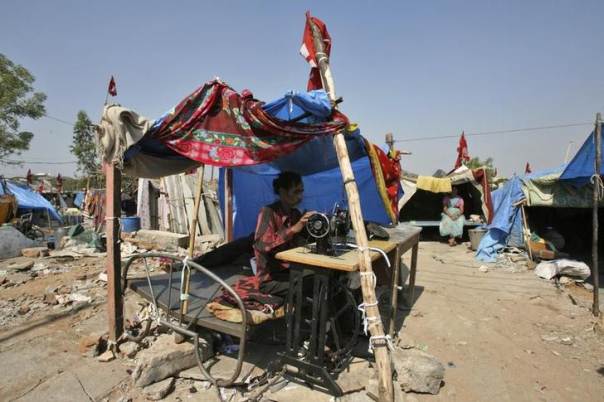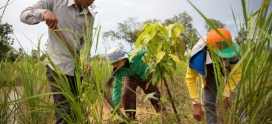Rethinking Microfinance’s Role in fighting against poverty
Much has been said about microfinance. Heralded once as the ultimate tool for alleviating poverty worldwide, it was badly hit by accusations of illegal and immoral practices in India’s Andhra Pradesh in 2010-2011 and, since then, has lost some of its shine.
Can we still look at microfinance as the ultimate tool in the fight against poverty or should we agree with its detractors that it is useless? I believe that the middle ground is closer to the truth. This opinion was forged through Green Shoots Foundation’s own experience with microfinance and explains why we eventually changed our mission and the way we look at microfinance.
Green Shoots Foundation was set up late 2010 as a UK charity whose mission was to help develop microfinance Greenfields by providing fairly priced and customer-centric microfinance to those who needed it most. Two years later, Green Shoots Foundation’s mission was changed so that the implementation of microfinance was no longer an objective per se but merely one of the tools in our fight against poverty. How did we get there?
As a charity, our fight has always been against poverty. So, let’s start with the basics, what is poverty?
Reducing poverty to an economic condition, for instance a poverty line threshold expressed in dollars per day, does not even scratch the surface. The impoverished are not just suffering from a lack of economic empowerment, they are also more exposed to illness/disease, to natural catastrophes, to violence, to deprivation of the most fundamental rights and this has a disastrous psychological impact. It makes them feel “unworthy” and entraps them in some sort of pernicious fatalism. Just imagine the frame of mind of a mother or father unable to provide their children with the most basic needs! Poverty should therefore be seen as complex and multi-dimensional.
If poverty is complex and multi-dimensional, can we realistically expect to address it with a single tool? Well, let us take one of these illustrative success stories that you will find on most microfinance institutions’ websites. “(Fatimah/Sophea/Elisabeth) received a loan that allowed her to buy the much needed (stock/farming tools/market place stall) leading to a substantial increase in income for her entire household and allowing her to send her children to school”. If you are familiar with microfinance, no doubt you have come across such success stories. But is this a proof that microfinance works single-handedly?
Objectively, it is not. One would struggle to prove by A+B that the loan received by (Fatimah/Sophea/Elisabeth) was the direct and sole cause for the improvement of livelihood in her household. Naturally, there is a correlation, but at what percentage factor? And how does it compare with other factors such as improved roads bringing in more business, more affordable health care made available through medical NGOs, or secondary education made possible through the building of new schools?
At Green Shoots Foundation, we initially looked at that very issue and, via a project of impact assessment called “Impact Lab”, we considered spending time and resources in defining those correlation factors. But soon two things became evident: i) the budget necessary for such a project would range in the millions and ii) the outcome would matter from an academic point of view but would not help us get any closer to our ultimate objective i.e. helping local communities fight poverty.
From our point of view, it ultimately mattered little whether we could prove that microfinance was directly and solely responsible for the improvement of livelihood. Why spend so much time and resources trying to “de-correlate” it from the other factors when we know that they work? As far as we are concerned, what really matters, is that microfinance is used as a tool for a noble purpose and not as an objective of money grossing business as was the case in Andhra Pradesh in India.
Let us consider the achievements of one Muhamad Yunus, one of microfinance’s greatest ambassadors. Beyond the dynamics of economically empowering the impoverished, Yunus’ greatest achievement was to cast a light of respectability on those who had been left in the shadow by the rest of society. Those who were once deemed unworthy of a loan, are now receiving the attention and focus of others and are called “clients”.
Is microfinance ideal? No. Can we scientifically prove that it works? That remains difficult. But one thing is more certain, by enabling the impoverished to see themselves as “worthy”, we restore what poverty had snatched away from them, their dignity. And, if anything, microfinance should be praised for that.
For our part, we decided to change Green Shoots Foundation’s mission and combine microfinance with other development tools such as access to education and medical aid. With a more holistic approach, we believe that we are better equipped to help local communities fight poverty and that our programmes of education loans, microfinance for people living with HIV or social entrepreneurship are creating synergies leading eventually to sustainability. To bring in the needed medical expertise, we merged in 2012 with another UK charity that delivered “Train the Trainers” medical programmes. If you are interested in supporting our programmes, volunteering for some of our missions or learning more about Green Shoots Foundation, please consult www.greenshootsfoundation.org
Source: Thomson Reuters Foundation: Rethinking Microfinance’s Role in fighting against poverty



